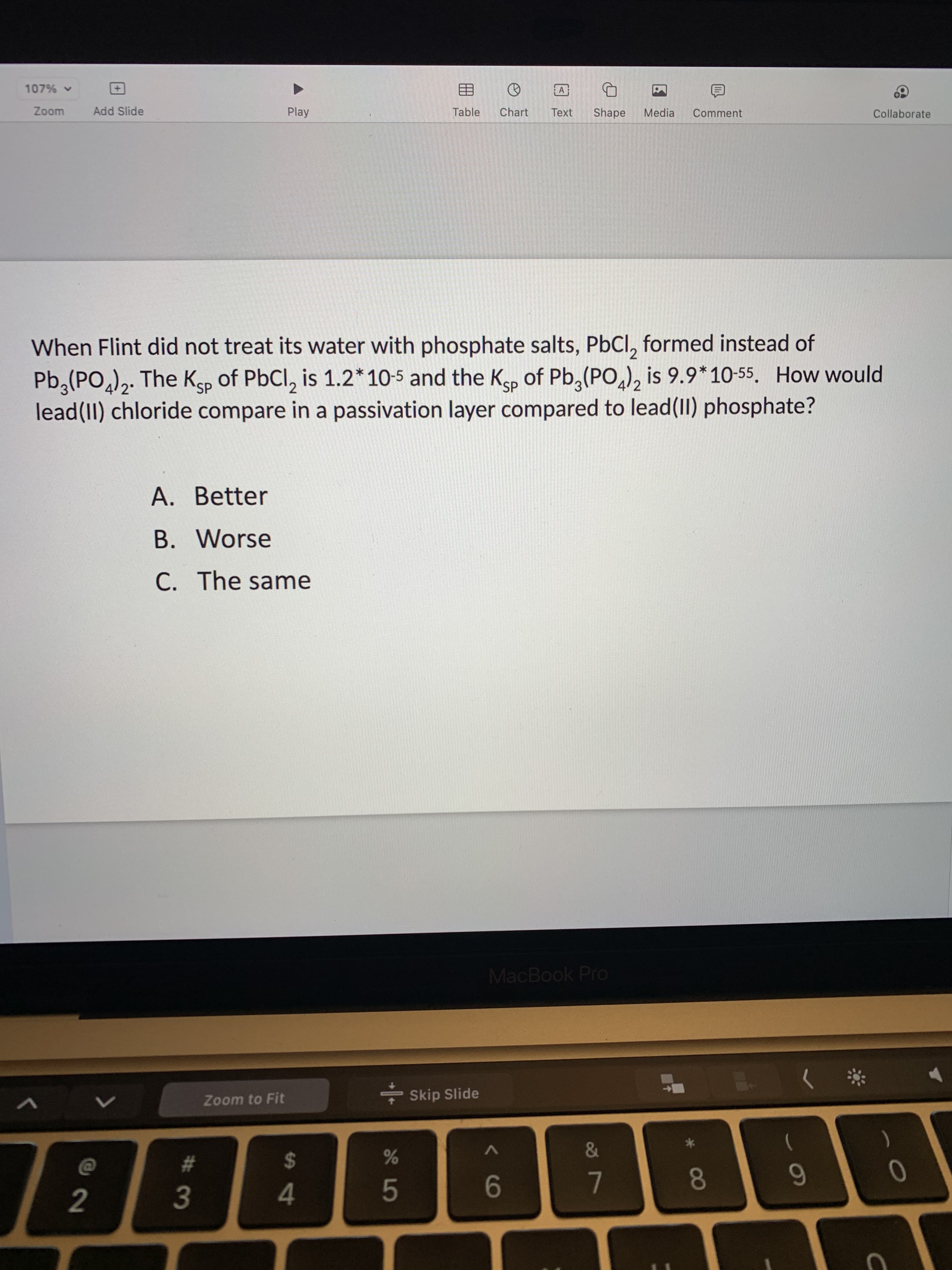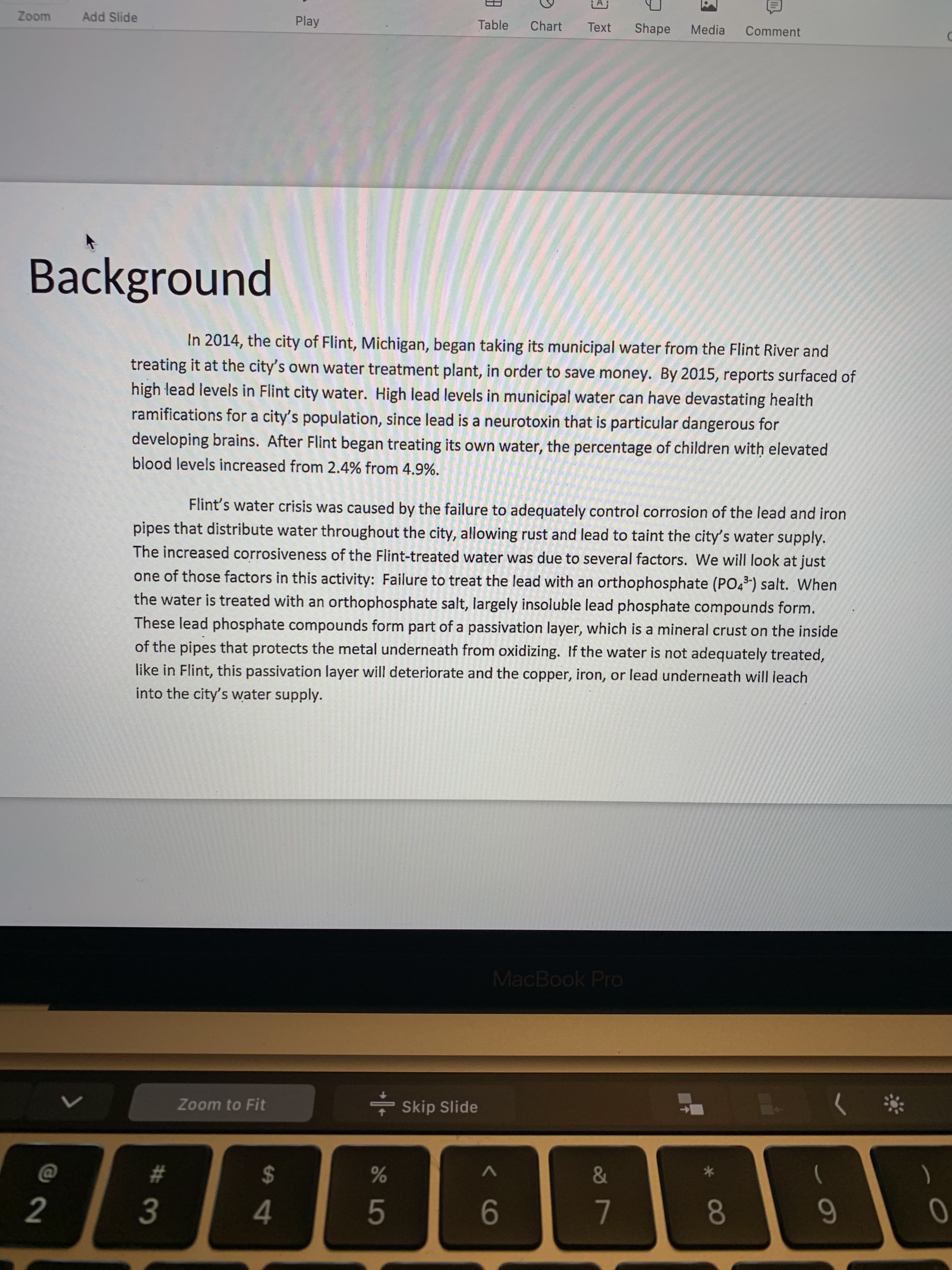%S4 #3 A %LOL Zoom 目 Add Slide Play Table Chart Text Shape Media Comment Collaborate When Flint did not treat its water with phosphate salts, PBCI, formed instead of Pb,(PO),. The Ksp of PbCl, is 1.2*10-5 and the Ksp of Pb, (PO,), is 9.9*10-55. How would lead(II) chloride compare in a passivation layer compared to lead(II) phosphate? 2° SP A. Better B. Worse C. The same MacBook Pro - Skip Slide Zoom to Fit %23 $ 08. 6 9 60 08 Zoom Add Slide Play Table Chart Text Shape Media Comment Background In 2014, the city of Flint, Michigan, began taking its municipal water from the Flint River and treating it at the city's own water treatment plant, in order to save money. By 2015, reports surfaced of high lead levels in Flint city water. High lead levels in municipal water can have devastating health ramifications for a city's population, since lead is a neurotoxin that is particular dangerous for developing brains. After Flint began treating its own water, the percentage of children with elevated blood levels increased from 2.4% from 4.9%. Flint's water crisis was caused by the failure to adequately control corrosion of the lead and iron pipes that distribute water throughout the city, allowing rust and lead to taint the city's water supply. The increased corrosiveness of the Flint-treated water was due to several factors. We will look at just one of those factors in this activity: Failure to treat the lead with an orthophosphate (PO43-) salt. When the water is treated with an orthophosphate salt, largely insoluble lead phosphate compounds form. These lead phosphate compounds form part of a passivation layer, which is a mineral crust on the inside of the pipes that protects the metal underneath from oxidizing. If the water is not adequately treated, like in Flint, this passivation layer will deteriorate and the copper, iron, or lead underneath will leach into the city's water supply. MacBook Pro Zoom to Fit - Skip Slide * > * 24 ) 23 2. 9 3.
%S4 #3 A %LOL Zoom 目 Add Slide Play Table Chart Text Shape Media Comment Collaborate When Flint did not treat its water with phosphate salts, PBCI, formed instead of Pb,(PO),. The Ksp of PbCl, is 1.2*10-5 and the Ksp of Pb, (PO,), is 9.9*10-55. How would lead(II) chloride compare in a passivation layer compared to lead(II) phosphate? 2° SP A. Better B. Worse C. The same MacBook Pro - Skip Slide Zoom to Fit %23 $ 08. 6 9 60 08 Zoom Add Slide Play Table Chart Text Shape Media Comment Background In 2014, the city of Flint, Michigan, began taking its municipal water from the Flint River and treating it at the city's own water treatment plant, in order to save money. By 2015, reports surfaced of high lead levels in Flint city water. High lead levels in municipal water can have devastating health ramifications for a city's population, since lead is a neurotoxin that is particular dangerous for developing brains. After Flint began treating its own water, the percentage of children with elevated blood levels increased from 2.4% from 4.9%. Flint's water crisis was caused by the failure to adequately control corrosion of the lead and iron pipes that distribute water throughout the city, allowing rust and lead to taint the city's water supply. The increased corrosiveness of the Flint-treated water was due to several factors. We will look at just one of those factors in this activity: Failure to treat the lead with an orthophosphate (PO43-) salt. When the water is treated with an orthophosphate salt, largely insoluble lead phosphate compounds form. These lead phosphate compounds form part of a passivation layer, which is a mineral crust on the inside of the pipes that protects the metal underneath from oxidizing. If the water is not adequately treated, like in Flint, this passivation layer will deteriorate and the copper, iron, or lead underneath will leach into the city's water supply. MacBook Pro Zoom to Fit - Skip Slide * > * 24 ) 23 2. 9 3.
Chemistry & Chemical Reactivity
10th Edition
ISBN:9781337399074
Author:John C. Kotz, Paul M. Treichel, John Townsend, David Treichel
Publisher:John C. Kotz, Paul M. Treichel, John Townsend, David Treichel
Chapter21: The Chemistry Of The Main Group Elements
Section: Chapter Questions
Problem 118IL
Related questions
Question

Transcribed Image Text:%S4
#3
A %LOL
Zoom
目
Add Slide
Play
Table
Chart
Text
Shape
Media
Comment
Collaborate
When Flint did not treat its water with phosphate salts, PBCI, formed instead of
Pb,(PO),. The Ksp of PbCl, is 1.2*10-5 and the Ksp of Pb, (PO,), is 9.9*10-55. How would
lead(II) chloride compare in a passivation layer compared to lead(II) phosphate?
2°
SP
A. Better
B. Worse
C. The same
MacBook Pro
- Skip Slide
Zoom to Fit
%23
$
08.
6
9

Transcribed Image Text:60
08
Zoom
Add Slide
Play
Table
Chart
Text
Shape
Media
Comment
Background
In 2014, the city of Flint, Michigan, began taking its municipal water from the Flint River and
treating it at the city's own water treatment plant, in order to save money. By 2015, reports surfaced of
high lead levels in Flint city water. High lead levels in municipal water can have devastating health
ramifications for a city's population, since lead is a neurotoxin that is particular dangerous for
developing brains. After Flint began treating its own water, the percentage of children with elevated
blood levels increased from 2.4% from 4.9%.
Flint's water crisis was caused by the failure to adequately control corrosion of the lead and iron
pipes that distribute water throughout the city, allowing rust and lead to taint the city's water supply.
The increased corrosiveness of the Flint-treated water was due to several factors. We will look at just
one of those factors in this activity: Failure to treat the lead with an orthophosphate (PO43-) salt. When
the water is treated with an orthophosphate salt, largely insoluble lead phosphate compounds form.
These lead phosphate compounds form part of a passivation layer, which is a mineral crust on the inside
of the pipes that protects the metal underneath from oxidizing. If the water is not adequately treated,
like in Flint, this passivation layer will deteriorate and the copper, iron, or lead underneath will leach
into the city's water supply.
MacBook Pro
Zoom to Fit
- Skip Slide
* >
*
24
)
23
2.
9
3.
Expert Solution
This question has been solved!
Explore an expertly crafted, step-by-step solution for a thorough understanding of key concepts.
Step by step
Solved in 2 steps with 2 images

Knowledge Booster
Learn more about
Need a deep-dive on the concept behind this application? Look no further. Learn more about this topic, chemistry and related others by exploring similar questions and additional content below.Recommended textbooks for you

Chemistry & Chemical Reactivity
Chemistry
ISBN:
9781337399074
Author:
John C. Kotz, Paul M. Treichel, John Townsend, David Treichel
Publisher:
Cengage Learning

Chemistry & Chemical Reactivity
Chemistry
ISBN:
9781133949640
Author:
John C. Kotz, Paul M. Treichel, John Townsend, David Treichel
Publisher:
Cengage Learning

Chemistry: The Molecular Science
Chemistry
ISBN:
9781285199047
Author:
John W. Moore, Conrad L. Stanitski
Publisher:
Cengage Learning

Chemistry & Chemical Reactivity
Chemistry
ISBN:
9781337399074
Author:
John C. Kotz, Paul M. Treichel, John Townsend, David Treichel
Publisher:
Cengage Learning

Chemistry & Chemical Reactivity
Chemistry
ISBN:
9781133949640
Author:
John C. Kotz, Paul M. Treichel, John Townsend, David Treichel
Publisher:
Cengage Learning

Chemistry: The Molecular Science
Chemistry
ISBN:
9781285199047
Author:
John W. Moore, Conrad L. Stanitski
Publisher:
Cengage Learning

Introductory Chemistry: An Active Learning Approa…
Chemistry
ISBN:
9781305079250
Author:
Mark S. Cracolice, Ed Peters
Publisher:
Cengage Learning

General Chemistry - Standalone book (MindTap Cour…
Chemistry
ISBN:
9781305580343
Author:
Steven D. Gammon, Ebbing, Darrell Ebbing, Steven D., Darrell; Gammon, Darrell Ebbing; Steven D. Gammon, Darrell D.; Gammon, Ebbing; Steven D. Gammon; Darrell
Publisher:
Cengage Learning

Chemistry
Chemistry
ISBN:
9781305957404
Author:
Steven S. Zumdahl, Susan A. Zumdahl, Donald J. DeCoste
Publisher:
Cengage Learning